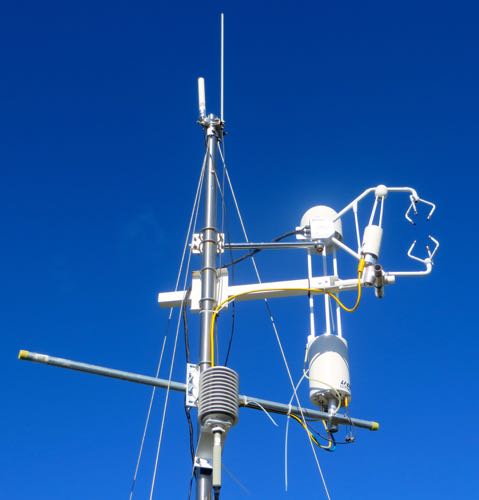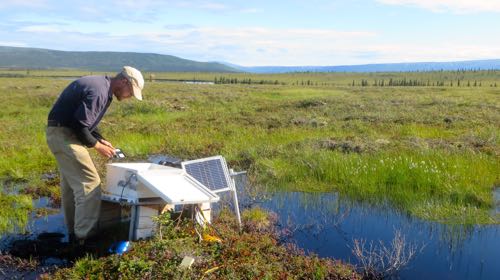The High One Unveiled
Today, we began our work at the Gradient Site, up the road from CiPEHR. It was a beautiful sunny morning, and I was blessed to see Denali, shining out from under the perpetual cloud cover. Denali, which means the "High One" in the Athabaskan language, was just last year, officially renamed, (from Mount McKinley), to honor the Native Americans who have lived in this area since migrating over the Bering land bridge thousands of years ago.
 Mount Denali - The High One
Mount Denali - The High One
Eddy Flux Covariance
The Gradient Site is home to the Eddy Flux Covariance Tower.
 Gradient Field Site
Gradient Field Site
I have never been much of a gear freak, and to be honest, I am more at home with plants and birds, and even the occasional spider than with electronics and whirly gigs. But I think I fell in love with this awesome piece of equipment. It is big, complex and intricate from my vantage point. But sublime too. Lets see if I can do it justice in describing all of its wondrous functions.
 Justin Ledman and the Eddy Covariance Tower
Justin Ledman and the Eddy Covariance Tower
Eddy flux covariance towers provide scientists information about the exchange rate of trace gases on the landscape scale. Towers, like the one at the Gradient site, are used to study natural ecosystems all over the world and are even used in agricultural fields to understand how crops take up and release water vapor and carbon dioxide. The towers are also used to help verify complex computer models and validate data collected from remote sensing satellites and aircraft.
The simplified version of how the towers work is to say that the device measures the "updraft and downdraft at the surface of the earth which result from turbulent eddies in the air". Video:
 Eddy Covariance
Eddy Covariance
Sonic Anemometer
This device, which looks like a robotic hand, measures three dimensional windspeed by "shooting ultrasonic waves back and forth".
 Sonic Anemometer
Sonic Anemometer
Infrared Gas Analyzer
This gizmo uses infrared light to measure carbon dioxide and water vapor concentrations. It takes 10 measurements every second. These high frequency measurements are then averaged and recorded once every 30 minutes.
 Infrared Gas Analyzer
Infrared Gas Analyzer
New Methane Sensor
Just last summer, a new methane sensor was installed on the tower. Data about methane release, a by-product of anaerobic respiration can now be collected on the landscape scale, which will compliment the data that Meghan Taylor will be collecting for the CiPEHR plots, (more on that later).
The methane sensor is the one that looks like a mini dome.
 Methane Analyzer
Methane Analyzer
Temperature and Relative Humidity
The tower collects atmospheric boundary layer temperature and humidity, and also has a probe that collects soil moisture and temperature.
Energy Budget and PAR
This part of the tower collects information on the incoming shortwave energy as well as outgoing long wave radiation. In addition, PAR, short for Photosynthetic Active Radiation, measures how much light is available to plants for photosynthesis.
 PAR and Energy Budget
PAR and Energy Budget
Solar and Wind Power
The Eddy Covariance Tower is powered by solar panels, as well as by a new wind turbine erected last year. Data from the tower is stored in a data logger and ideally could be transmitted to the lab via a cell tower. Unfortunately, the Gradient Site is just out of range of a cell tower, so Justin must go out into the field every two weeks to pick up the data cards and download the data to the computer manually.
 Wind turbine that helps to power the tower
Wind turbine that helps to power the tower
Visual Evidence of Warming
In the last couple of years, the Gradient Site has submerged under water in several locations. Justin has even had to move one of the instruments to higher ground. As the tower records atmospheric carbon flux and temperature, the tundra records the thawing landscape in the puddles that have begun to populate the horizon.
 Justin Ledman stands in tundra that is now under water due to thaw
Justin Ledman stands in tundra that is now under water due to thaw

Comments